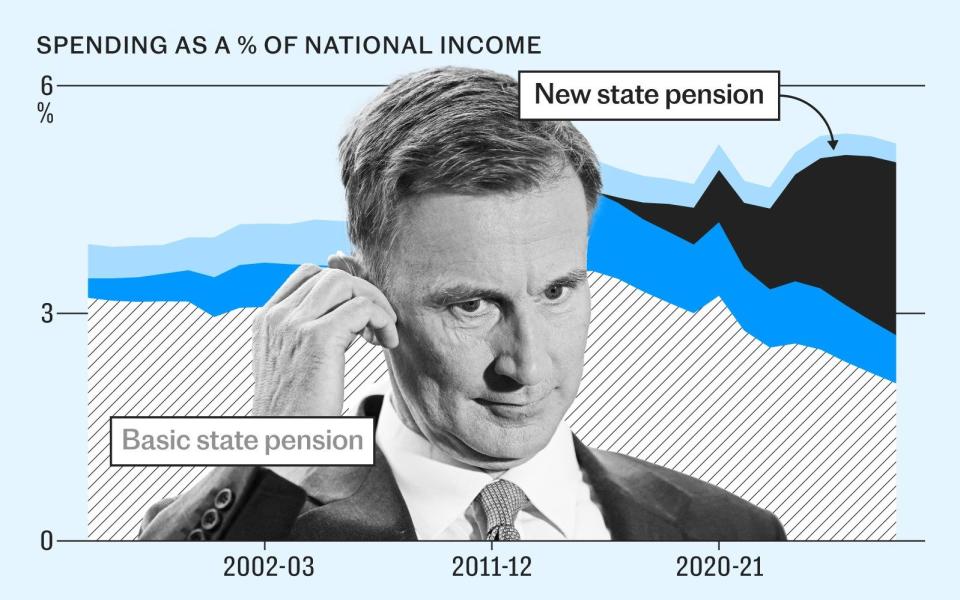
Pick up your annual tax summary from HMRC and you will see 10pc of what the Government takes from you goes towards the state pension.
It gives the impression that you, the taxpayer, are storing up a substantial nest egg to protect you in retirement.
The phrase “National Insurance Contributions” (NICs) suggests that this tax goes into a fund that will be there to pay our state pension on retirement, or help with benefits should you need them.
Unfortunately, anyone who gets that impression would be terribly mistaken. The money is not saved – taxes and NICs that are paid to HMRC today go straight out the door to pay pensioners who are currently claiming their retirement benefits.
Each generation’s pensioners rely on the taxes of younger workers, an intergenerational compact that relies on continued participation.
In the second of our three-part series on the future of the state pension, we look at how the myth of the “state pension pot” has evolved and what it means for the country.
National Insurance is set to bring in just over £176bn for the Government in the coming financial year. Spending on pensioners – covering the state pension, pension credit, housing benefits for retirees and other support – will total £152bn.
That leaves £24bn that theoretically could be set aside for future pension payments. Yet instead it goes towards spending on health, social care and any other parts of the state that needs the cash.
The absence of any real ring-fenced pension pot is a problem. Britain’s population is ageing, meaning there are a growing number of pensioners.
The state pension is rising at the same time thanks to the ratcheting effect of the triple lock.
Under the current system, a growing number of retirees will be claiming increasingly generous payments that rely on the taxes of a relatively smaller pool of workers.
In the short-run, taxpayers will be squeezed to cover the cost. National Insurance payments are set to rise by £25bn by 2028-29, the Office for Budget Responsibility (OBR) estimates, as frozen thresholds at a time of high inflation pull more workers into paying the tax.
Pensioner payments are set to grow by around £20bn over the same period, meaning the ledger will balance.
However, how long this arrangement will hold politically is an open question.
Increases in National Insurance are fuelling a rise in the tax burden to levels not seen since the aftermath of the Second World War. The issue is growing more politically toxic by the day.
The strategy of asking today’s workers to pay for current retirees’ pensions risks reaching breaking point.
The “pay as you go” method of financing the state pension has been enshrined in the system ever since it came into being in its modern form in 1948.
William Beveridge, the Liberal politician who helped engineer the welfare state, wanted a different model. He wanted workers to pay in first before qualifying for the pension.
However, the Government was not keen to charge workers a tax for years before introducing a pension given the impoverished, war-weary state of the nation. Instead, it introduced an immediate financial safety net paid for through current taxes.
The details of the system have changed since then. Past arrangements included earnings-related additional pensions, which allowed people to pay extra for a bigger pension, or a second state pension for low earners.
Today, the new state pension, which was introduced in 2016, is a simple flat rate. Those who qualify get £203.85 per week, a figure which rises each year in line with the triple lock – the highest of inflation, average wages or 2.5pc.
Workers need to rack up 35 years of National Insurance contributions to qualify for a full pension.
Contributions are deducted automatically from people’s pay cheques once they are earning more than £1,048 a month.
However, there are also other ways to build up eligibility – signing up for unemployment benefits while hunting for a job also counts to the 35 year requirement, for instance. Similarly, parents who receive child benefits also gain credit. The policy means that those who take time off work to raise a family do not blow a hole in their retirement provision.
The generosity of the current system means Britain is “rapidly moving to a state pension system in which most people who live in the UK all their adult life get a full state pension”, according to the Institute for Fiscal Studies (IFS).
Even people who take government-backed training courses can gain eligibility, points out Jonathan Cribb at the IFS. It means the liability of the state pension swells even as the income from National Insurance does not.
Then there are top ups available to help those without a full new state pension with living costs, including pension credit and housing benefit. On top of that come old age handouts such as winter fuel payments and free bus passes.
For those in retirement today, all of this is good news.
“It provides a good base layer of income, particularly if you are a couple, particularly if you own your own home,” says Cribb. “With two full state pensions, you are definitely not going to be in income poverty with that.”
Yet in terms of funding, the system is not particularly coherent. The link to National Insurance, for instance, is not consistent.
Pensions or future allowances did not rise when Rishi Sunak as Chancellor increased the rate of National Insurance contributions in April 2022. Nor did they fall when Kwasi Kwarteng reversed the increase or when Jeremy Hunt cut the tax further at the start of this year.
Meanwhile, someone who has achieved 35 years of NI contributions is still charged National Insurance even though it is of no further use to their ultimate pension allowance.
The inconsistencies highlight the increasingly shaky position of the state pension.
Politicians have long acknowledged a brewing problem but past attempts to solve it have proved futile.
In 1997, the Conservatives proposed turning the “pay as you go” system into a “fully funded” arrangement. Workers would pay the same tax and National Insurance but a chunk would be invested in the manner of a private pension pot, hopefully growing over time.
However, pension reform was not the issue of the day and Tony Blair’s Labour party vanquished John Major’s Conservatives in that year’s election. The proposal was left to gather dust.
The coalition government took steps towards addressing the issue by introducing auto enrolled private pensions in 2012.
Unless workers opt out, or do not meet the minimum income threshold, a slice of their earnings now go into a savings scheme that will give them a pension on retirement. The share of employees with a private pension has risen from below half in to almost 80pc as a result.
Auto enrolled pensions should theoretically wean future retirees off a dependence on the state pension, giving governments leeway to reform the way it is funded or how much it pays out.
Yet the wild success of the triple lock, which was also introduced by the coalition government around the same time, has effectively nullified this opportunity. Successive administrations have struggled to do anything other than increase the generosity of the state pension.
Rishi Sunak plans to retain the “triple lock” on state pensions if he wins the next election, the Telegraph revealed this week. It is a sure vote winner – yet the issue of who and how these future promises will be sustainable paid for remains.














